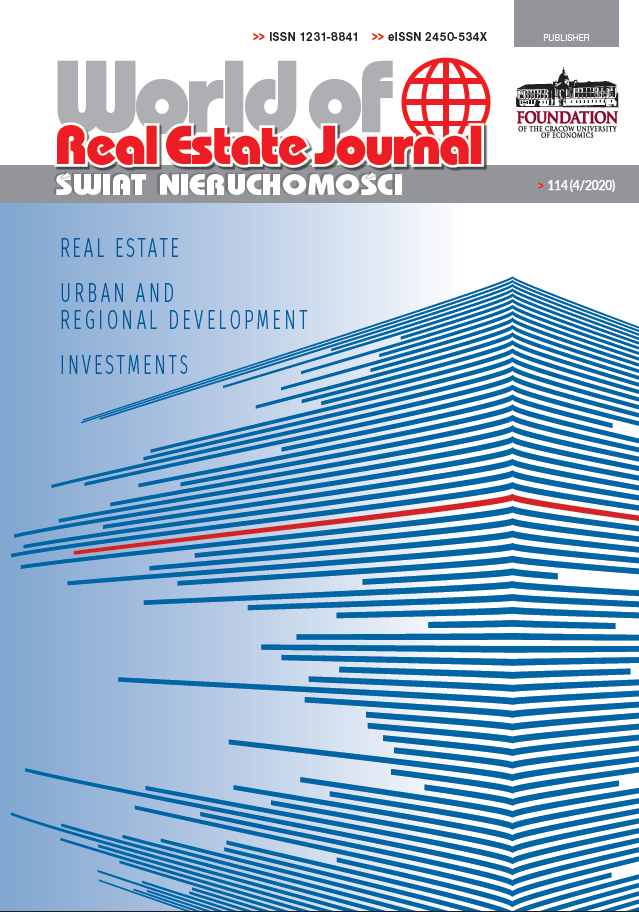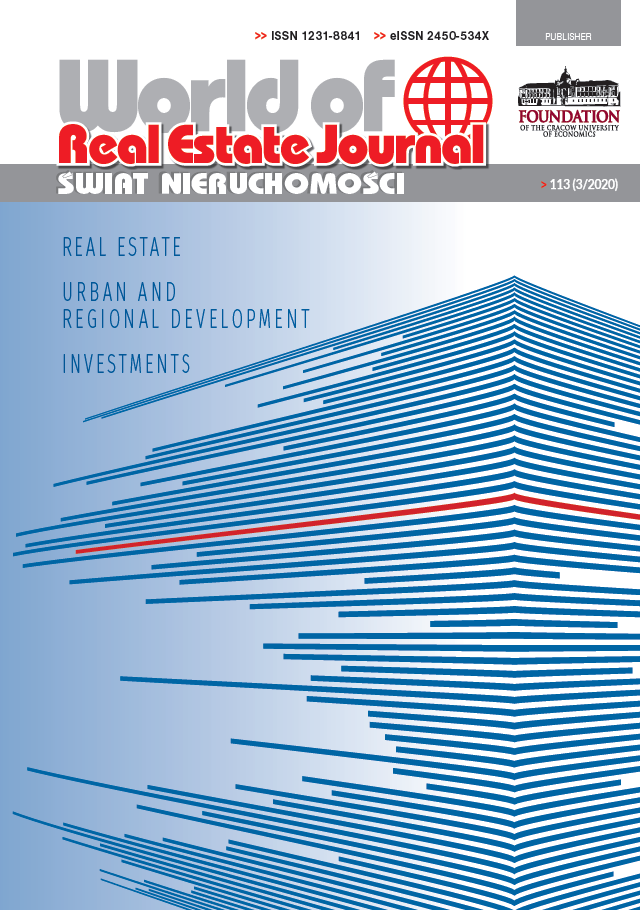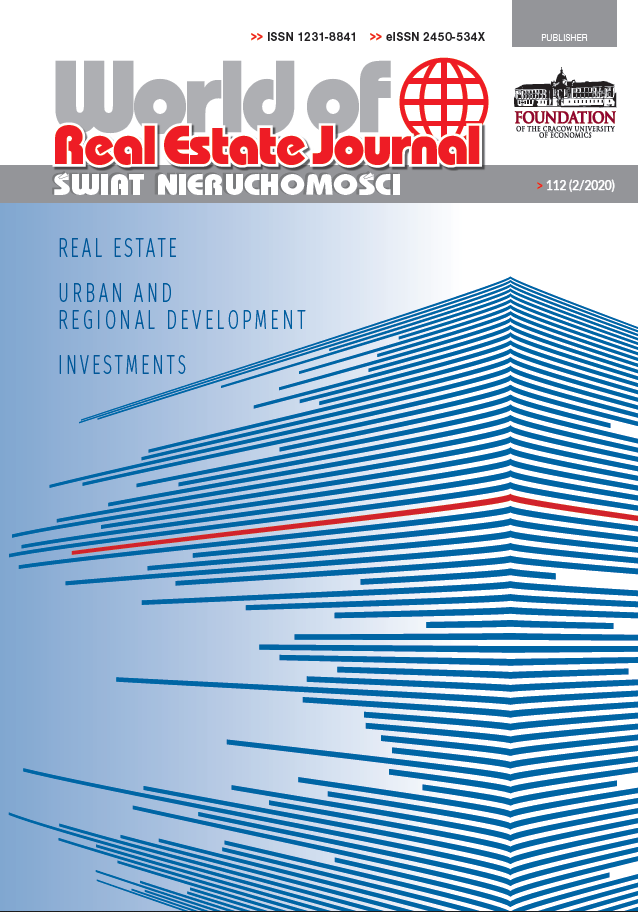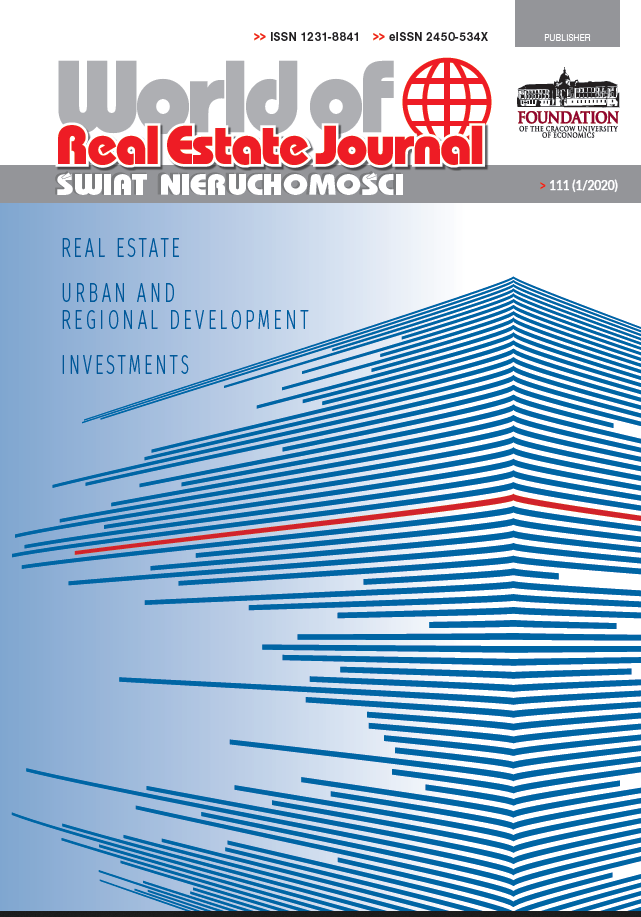WORTH NOTING
1) Bogusław Luchter – Changes in land use in selected areas of City of Cracow between 1848 and 2008
REAL ESTATE MANAGMENT
2) Aneta Zaremba, Maciej J. Nowak - Land, real estate property, plot of land – legal and economic notion
3) Katarzyna Najbar, Adam Nalepka – Property management companies in Poland
INVESTMENTS
4) Marzena Bac - Insurance as an instrument of Risk Management in the construction project of motorway section
5) Wojciech Drozd, Krzysztof Zima - Modular formwork as a component forming modern architecture – a technical-economical analysis
MARKET
6) Barbara Stolińska - Regulations of real estate acquisition by foreigners in UE’s countries on the example of Austria and Portugal
7) Agnieszka Kowalska – Real Estate Agency in Spain and in Poland
HOUSING
8) Artur Zimny - Housing allowances – legal and statistical analysis
CHANGES IN REAL ESTATE LAW
9) Maciej J. Nowak - Amendments to the Real Estate Management Act DOWNLAND
CONFERENCES
10) Małgorzata Uhruska - ERES Industrial Seminar Moscow 2009. Commercialreal estate marketin Russia, Yesterday -Today-Tomorrow (Moskwa, 30 October 2009) DOWNLAND
11) Dawid Deręgowski, Beata Rachoń – Seminar "The professional activityin the housing market" (Kraków, 15 December 2009) DOWNLAND
12) Iwona Strzępek – VII Editing Program ”The European Real Estate Challenge” (Berlin, 9-21 January 2010) DOWNLAND
ON THE PUBLISHING MARKET
13) Stanisław Belniak - Marzena Bac „Zarządzanie ryzykiem katastroficznym w nieruchomościach. Rozwiązania ubezpieczeniowe w Polsce i na świecie” – review DOWNLAND
SUMMARIES
Bogusław Luchter - Changes in land use in selected areas of City of Cracow between 1848 and 2008
The paper aims at evaluation of changes in land use that took place within last 160 years (1848-2008) in selected administrative areas of Cracow. The research included several such spatial – administrative entities but only in case of former administrative district of Podgórze, such evaluation has been feasible. In case of the other (i.e. former administrative districts; presently fundamental land survey registration entities, cadaster entities , i.e. former villages and towns included in the City of Cracow, registration districts etc.), comparability in such long term is not possible and would require further research or arduous calculations, not always feasible, tough, as the access to data and sources of historic significance is limited. Further observation of the process of land use transformations in the longer period of time, is possible if former administrative districts are retained as fundamental land survey registration entities and it also allows for spatial differentiation of the analyzed phenomena.
Anta Zaremba, Maciej J. Nowak - Land, real estate property, plot of land – legal and economic notion
The aim of the article is introduction to exhaustive definition of notions like the ground, immobility and soil in law and economy language. Even in the same scopes of science there are sometimes terminological discrepancies. In the article especially were taken into account terms of agricultural -soil and agricultural – immobility.
Katarzyna Najbar, Adam Nalepka - Property management companies in Poland
The aim of the article is to present the results of the research conducted among the real estate professionals (property managers, real estate brokers, property appraisers) in Poland. Part of the research concerned the performance of the property management companies in the context of their activities and organizational structure. The paper describes the qualitative and quantitative characteristics of the property management subjects, and also analyzes the functional and operational aspects of such companies performance.
Marzena Bac - Insurance as an instrument of Risk Management in the construction project of motorway section
The article introduces the insurance as the method which makes it possible to cover financial results of accomplishing the risk in the motorway construction. There are discussed broad risk classifications for investment projects and examples of the risk in the motorway construction along with effects of its accomplishment. The insurance products covering the risk connected with the analyzed investment offered by the insurers in Poland is also presented.
Wojciech Drozd, Krzysztof Zima - Modular formwork as a component forming modern architecture – a technical-economical analysis
In the article, authors describe choose types of modern modular formwork. Formwork analysis assume formwork rent costs and technical solutions. Authors compared modular formwork with traditional lumber formwork, pointed at highly possibilities of modular formworks, especially at forming a modern architecture, by similar costs of formworks. Highly needs assumed to building shape, texture and smoothness of buildings walls (usage of architectural concrete) constrain using modern modular formwork.
Barbara Stolińska - Regulations of real estate acquisition by foreigners in UE’s countries on the example of Austria and Portugal
This article is intended to provide an overview of the most important legal considerations related to real estate transactions in selected jurisdictions and covers Austria and Portugal. The article characterizes the main rules regarding acquisition of real estate by foreigners in counties mentioned above. Its purpose is to present property acquisition’s rules by providing legal insight and information necessary for having a general overview on the matter.
Agnieszka Kowalska - Real Estate Agency in Spain and in Poland
Real estate agencies seem to work according to the same rules in particular European countries. Some real estate’s features as well as a recession on the European real estate market as a result of American crisis may lead to this conclusion. Anyway some of the cultural differences may have a great impact on the activity of this kind of institutions. Comparative analysis was carried out in Plock and Santiago de Compostela, because of a similar number of inhabitants and also of this kind of firms in these cities. The research showed that although there are a lot of similarities related to the number of employees, the time of existing on the market, having subsidiaries or the ways of promotion, agencies have some different features. One of them is a willingness to negotiate with a client as far as commission is considered, as well as the hours of work, where cultural differences are also significant. Anyway the most surprising result is the attitude to the students that may want to have practice in this kind of firms. In this case Spanish students have incomparably more opportunities although they are not very prone to gain some professional experience. People working in real estate agencies are keen to take part in some similar research in future. Their openness may have a positive impact on a real estate market, which is very difficult to analyze because of its specific features.
Artur Zimny - Housing allowances – legal and statistical analysis
The aim of this elaboration is to present regulations relating to the grant and payment of housing allowances and to make statistical analysis of allowances paid out in Poland in recent years. In the first part of the article were used regulations of Act of 21 June 2001 on Housing Allowances and its implementing regulations, whereas in the second part the information available at Regional Data Bank, which were analyzed in a regional aspect by using basic statistical tools. Based on available statistical data it can be stated that the number and amount of housing allowances paid out in Poland were steadily decreasing in the years 2004-2008. These benefits were used to a large degree in Kujawsko-Pomorskie Province and Warmińsko-Mazurskie Province and to a small degree in the regions of the Świętokrzystkie, Małopolskie, Podkarpackie and Mazowieckie.





















































